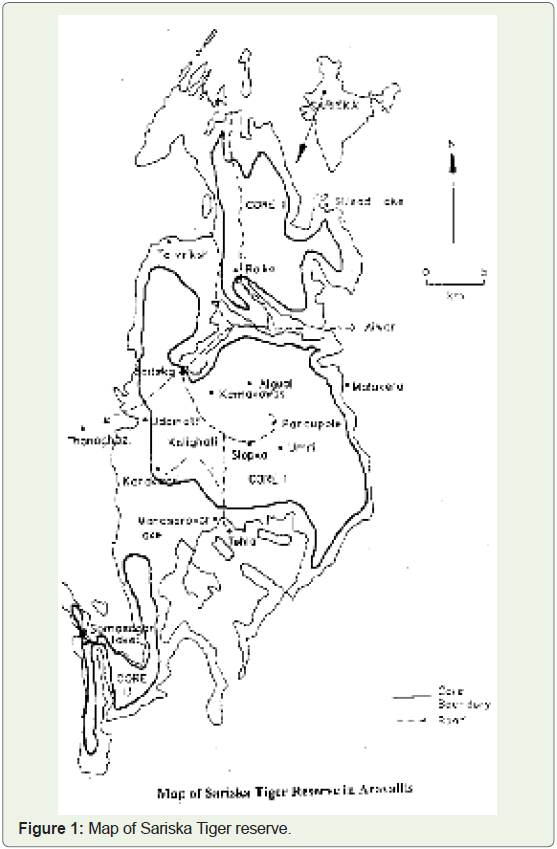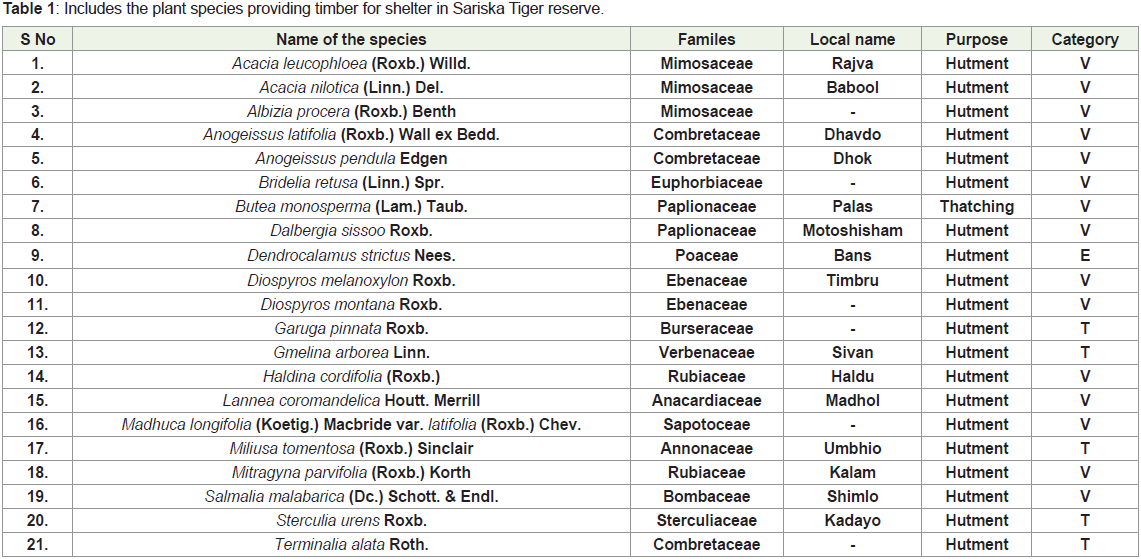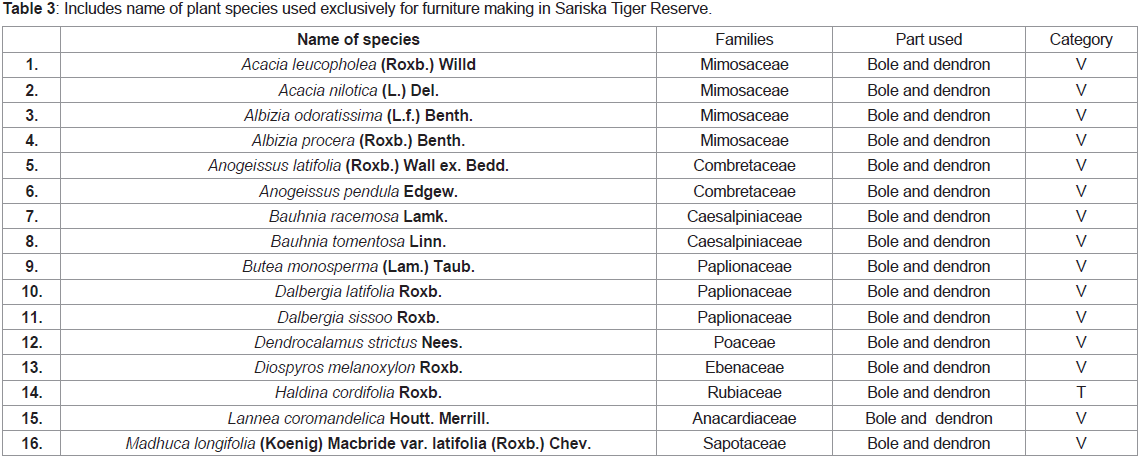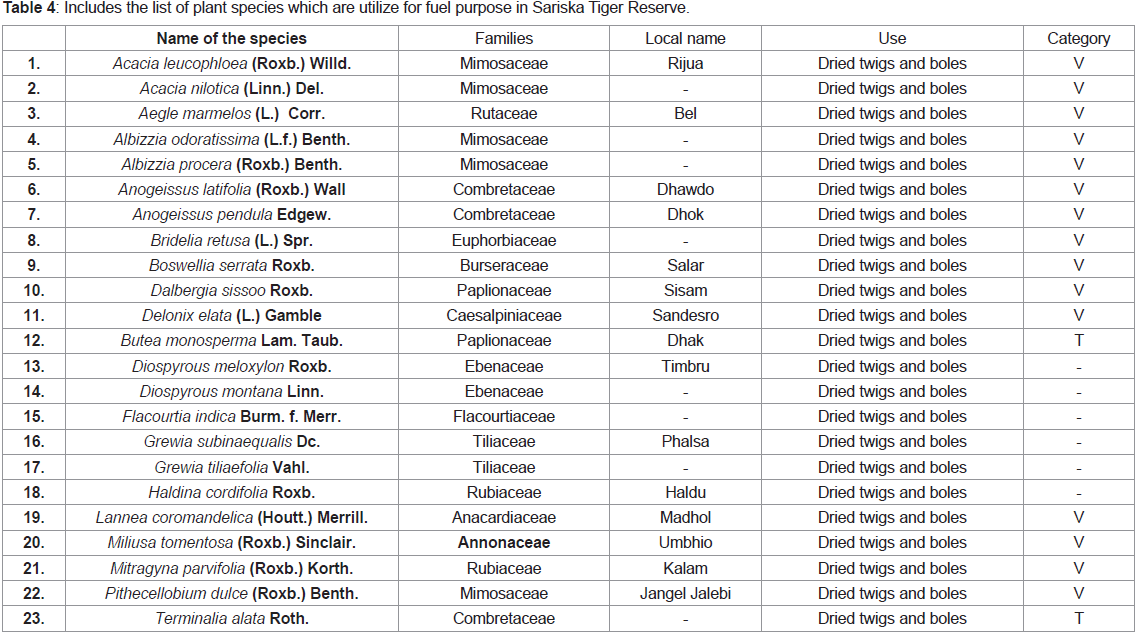Research Article
Study of some economic important plants of Sariska tiger reserve in Aravallis
Dular AK*
Department of Environmental Science, Maharaja Ganga Singh University, N.H. 15, Jaisalmer Road, Bikaner-334004,
Rajasthan, India
*Corresponding author: Dular AK, Department of Environmental Science, Maharaja Ganga Singh University, N.H.
15, Jaisalmer Road, Bikaner-334004, Rajasthan, India; E-mail: dular_ak@rediffmail.com
Copyright: © Dular AK. 2022. This is an open access article distributed under the Creative Commons Attribution License, which
permits unrestricted use, distribution, and reproduction in any medium, provided the original work is properly cited.
Article Information: Submission: 23/03/2022; Accepted: 05/05/2022; Published: 09/05/2022
Abstract
Present work has been carried out in one of the reserved forest area of the state of Rajasthan i.e. Sariska Tiger Reserve (STR). The study area is a
part of Aravalli range. Being the oldest mountain system, It is rich in minerals as well as it harbours rich fauna, flora and ample of wildlife. The reserve has
immense ecological and geomorphological significance. It is a highly complex ecosystem formed by the Northern Tropical dry mixed deciduous forests. A
large number of species have become economic important species from the most common species in due course of time in the present study areas. The
Aravalli is the repository of biodiversity, the rich diversity of study area used by inhabitant for fodder, fuel, timber, agriculture tools and medicine etc.
Keywords
Biodiversity; Sariska tiger reserve; Aravallis Economioc important plants
Introduction
According to the Champion and Seth (1968) the forest of Aravalli
region falls under the broad category of Tropical Dry forests. Study
area the “Sariska Tiger reserve” (74°14´ to 76° 34´ N and 25° 5´ to 27° 3´
E) is situated in the Aravalli hill range and lies in the semi-arid part of
Rajasthan (Rodgers and Panwar, 1988). It became a wild life sanctuary
in 1955 and Tiger reserve in 1982. According to Department of Forest,
Government of Rajasthan the total area of the Sariska Tiger Reserve
is 866 sq km, of which 302.2 sq km is buffer zone and 497.8 sq km is
core zone. Sariska core zone is comprised of three isolated; pockets:
Core-I (273.8 sq km), II (126.5 sq km) and III (97.5 sq km). The status
of the Core I has been notified as a National park in 1982. Sariska is
undulating to hilly and has numerous narrow valleys. Kiraska and
Kankwari plateau and two large lakes Mansarovar and Somsagar.
Silisad lake is situated just along the north eastern boundary of the
reserve. The altitude of Sariska varies from 540 to 777 meters. The
vegetation of Sariska correspond to Northern tropical dry deciduous
forests (sub group 5 B; 5/E I and 5/E2) and Northern tropical thorn
forest (Sub Group 6 B). The forest being scattered and sparse over a
large area on various geological and soil formation and vary greatly in
composition. Sariska is very rich in biodiversity with wide spectrum
of flora and ample of wild life. The main economically valuable
species are dhok (Anogeissus pendula) salar (Boswellia serrata), khair
(Acacia catechu), bamboos (Dendrocalamus strictus), dhak (Butea
monosperma), kair (Cappais decidua), ber (Zizyphus mauritiana)
with having lot of ground flora comprised of shrubs, herbs, grasses
and sedges etc [1-4].
Material and methods
Personal observations were taken in the field by visiting the study
area and its different landforms. It was a great help that the field
staff of Sariska Tiger Reserve, Department of Forest, Government
of Rajasthan was associated always in the field. Plant samples (leaf,
flower etc.) were brought to Indira Gandhi Centre for Human
Ecology, Environmental and Population Studies, herbarium sheets
for important species were prepared and help and cooperation was
sought from the “Herbarium” of Department of Botany, University
of Rajasthan, Jaipur for finding out their feasibility of uses as forest products. Interview has been taken for counter check of their utility
by local dwellers inside or outside the reserve. The inventorization of
such species and their parts utilize checked by literature authentically Figure 1.
Result and Discussion
Several studies so far conducted in Aravallis like Nair and
Nathawath1957, Dennis etal1977, Sharma 1978, 1983, Parmar1985,
Rogers1988, 1990, 1991, Khan1995 which supported checklist of
plant diversity in this natural reserve with their economic uses at local,
besides this in other region studies like Samant and Dhar1997, Joshi
2000, Gamble 1884, Ghate 1939, Legris and Meher Homji,1982 on the
prospects and valuation of biodiversity in form of economic important
plants as the source of income for the livelihood. The Himalaya is the
repository of biodiversity. The rich diversity of the species is used by
the inhabitants for fodder, fuel, timber, agricultural tools, medicinal,
edible, religious and various other purposes [5-10]. The inventory of
useful resources of the protected areas provides an array of existing
information. The present study provides comprehensive information
on life forms, altitudinal range, nativity, endemism, parts used and
indigenous uses as medicine, edible, fodder, fuel, agricultural tools,
religious and various other aspects. Such baseline information on
the useful species is very much important to assess the population in
wild, identify their economic and conservation values. Phytochemical
investigation of medicinal and edible plants provides information
about the biologically active compounds, which is very much
important for the identification of potential values of these species
[10]. Quantitative assessment of such resources using standard
ecological methods and their extraction trends are urgently required.
Analysis of interview schedule has revealed that there is large number
of plant species with economic value. Plant species are utilized for
variety of purposes. Table 1 includes twenty one species providing
timber for shelter and other purposes. Table 2 includes names of nine
species utilized for making agricultural implements. Table 3 includes name of sixteen plant species used exclusively for furniture making.
Table 4 included a list of thirty eight plant species which are utilized
for fuel purposes [11-17] (Table 1-4).
Table 3: Includes name of plant species used exclusively for furniture making in Sariska Tiger Reserve.
Conclusion
In this study emphasis was laid on the floral diversity with their
uses as economic value important products for the subsistence and
livelihood of local dwellers inside and outside the Sariska Tiger
Reserve . The study revealed that the loss biodiversity of the study
area due to anthropogenic activities leads in scarcity of economic
important species, which is basis of livelihood of local peoples. Due
to the human interference in reserve will lead to deterioration of so
many species which have great importance to generate economy for
local peoples, and uses of such economic important plants species of
the reserve so far.
Acknowledgement
Author has deep sense of gratitude to his supervisor Director
Indira Gandhi centre for Human Ecology and Population studies,
University of Rajasthan, Jaipur for their able guidance during the
research tenure and also thankful to Dept of forest, Government of
Rajasthan and field director to Sariska and other staff members.





